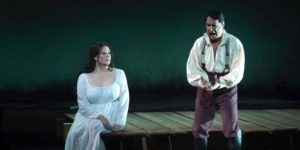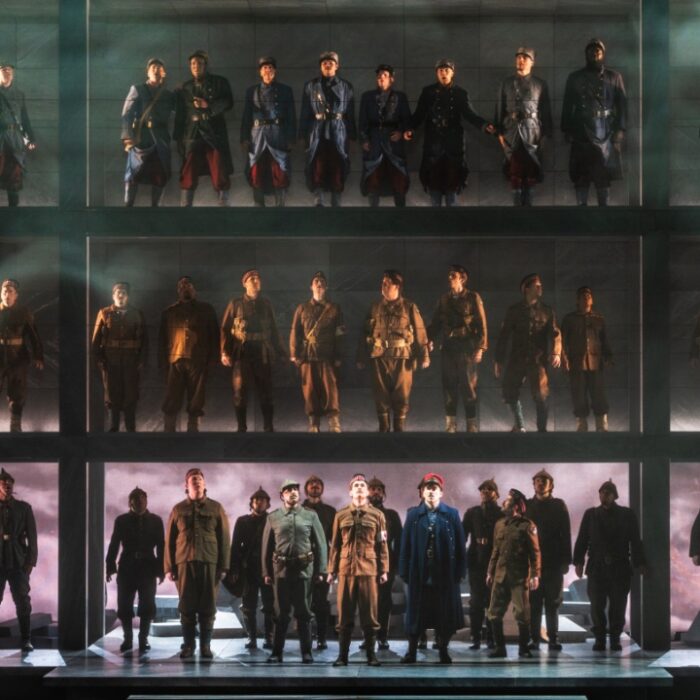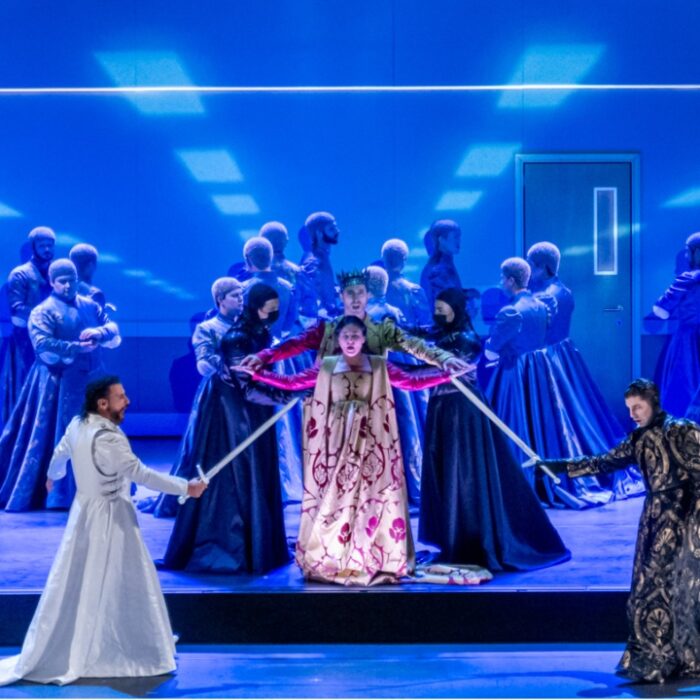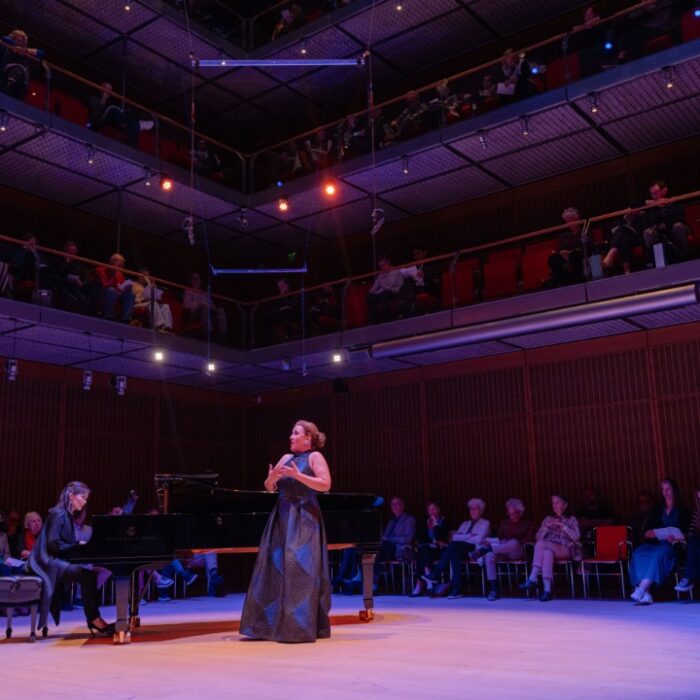
Teatro Real de Madrid 2022-23 Review: La Sonnambula (Cast B)
Jessica Pratt Triumphs in Bellini’s Musical Masterpiece
By Mauricio VillaThe Teatro Real de Madrid has rounded out the year with 13 performances of Bellini’s “La Sonnambula,” a title which had not been performed in Madrid for 22 years. What is often considered Bellini’s most balanced composition was presented with a strong double cast of international singers and a new production directed by the Spanish stage director Barbara Lluch.
Salem & La Sonnambula
Lluch sets the action in a village reminiscent of Salem’s rural superstitious society at the end of the 17th century—famous for its’ witchcraft trials. This thematic connection to the fear-mongering culture of Salem is represented by the cast’s costumes and their grey color palette—designed by Clara Peluffo—and their alienating behavior. They behave like a group that not only believes in ghosts, but turns from loving Amina to despising her and isolating her when they believe her to be unfaithful to her fiancé Elvino. But to achieve this intentionally repressive atmosphere static staging was also extensively utilized, which made many scenes, especially those involving the chorus, linear and boring. Lluch compensated for this by adding a contemporary ballet which, I suspect, was intended to serve as a visual, abstract representation of Amina’s feelings. The overuse of dancers, however—who danced even without music at the beginning of both acts—and an archaic contemporary choreography—too reminiscent of the Graham School of Dance—did not pair well with the beautiful melodies of Bellini, nor the narrative of the plot—which is rather simplistic and weak. These visual flourishes turned out to be annoying and unnecessary in many scenes. The choreography did not blend well with the onstage action or the music, resulting in an absurd, isolated dance. Visually, there were references to the Industrial Revolution, seen in the chopping down of trees in the first act, and the smoky, factory machine in the first scene of Act Two. There was a clear intention to provide, through these visual elements, a social message. But the feminist intent behind changing the end of the story—wherein Amina remains atop a roof, rather than joining her fiancée Elvino, who had previously mistreated her in public, below—did not correspond with the lively, joyful music of the final cabaletta. This is yet another example of how stage directors can ignore the story and music of the operas they work with to instead impose their own, ‘original’ dramaturgy, with inevitably poor results. Their ideas often conflict with the music, which is what establishes the atmosphere and psychological state of operatic characters. Despite these issues, the production was easy on the eyes, the sets were both beautiful and meaningful. It is not a great production, but it is definitely not the worst one out there.
A Captivating Soprano
Internationally acclaimed Australian soprano Jessica Pratt portrayed the title role of Amina. Her lirico-leggera voice has grown and expanded into the middle register and up to A natural, where her voice has become stronger and darker. Her entrance aria, “Care compagne…come per me,” was a lesson in true bel-canto. Expansive legato lines, exquisite diminuendo, B flats in pianissimo without portamenti; while the cabaletta was a showcase of fast trills, roulades, scales, and interpolated staccato high notes including a shining E flat. Her interpretation of the chromatic roulades in ascension to high C in the final section of the cabaletta “Balzar” was memorable for her depurated and clean coloratura technique. She finished the piece by crowning the cabaletta with a strong, long, sustained E flat. She delivered strong high Cs on the stretta that closes Act One, perfectly audible over the other soloists, chorus, and orchestra playing in forte, and a final E flat sustained during ten long bars. The highlight of her performance was her long final scene, “Ah! Se una volta… ah! Non credea mirarti… Ah! Non giunge.” She gave a moving interpretation of the sleepwalking scene, the detail and inflection of every line in the recitativo expressing the deep sorrow of the unfortunate heroine. The aria was sung with delicacy, and soaring long lines in mezza voce, pressing a deep sense of grief and distress. Her final cabaletta put her coloratura to the test with quick scales, staccato notes, several interpolated E flats, and crowning the end with an impossibly, stratospherically high F. Her interpretation was, in general, full of ethereal, long, legato lines and splendid vocal pyrotechnics.
Mixed Results
Italian tenor Francesco Demuro is a clear example of why splendid strong high notes—even in a bel-canto role written for the tenor Rubini, who was famous for his stratospheric vocal range—do not win an entire performance. His voice can be shaky and has a vibrato in the center and middle register which makes his sound often unstable. His opening B flat in “tu rendesti il padre” sounded strangled. He sang the andante “Prendi l’anel ti dono” with an absence of dynamics, singing mostly in forte and ignoring all the indications of the score. But Demuro can deal effortlessly with high tessitura. He easily made the high Cs in “Tutto, ah! Tutto in quest’instante,” although he needed an appoggiatura during the attack on the second high C in “Nel tuo vezzo,” rather than the clean, direct attack which the score demands. Demuro’s voice navigates comfortably through the tessitura of the duet “Son geloso…” which demands phrasing around high B flats and high Cs, although the middle section of the duet had the traditional cut, reducing the number of high notes. Sometimes what sounds like a hiss of air can be heard at the end of his high notes, which indicates that the pressure of air that he is using to produce the note is excessive. There was only one occasion when Demuro sang mezza voce during the night, at the end of the duet in “Pur nel sonno il mio cor ti verdra.” He finished the duet with a ringing strong high C in the vowel ‘I‘ in the final line “Addio!” which is very difficult to achieve, as this vowel is closed and it is usually easier to sing high notes with open vowels. He sang in forte with no dynamics for the majority of his aria “Tutto è sciolto.” He was solvent in the coloratura section, and with the help of conductor Maurizio Benini’s slow tempo delivered strong As and B naturals. It was very brave of him to interpolate a long, strong, and exposed high D on the repetition of the cabaletta “Ah! Perchè non posso odiarti,” as well as a high C at the end before resolving down into a high B flat. He also sang the high C in the Quartet “Lisa mendace anch’esa,” but he lacked delicacy and emotion in his lines during Amina’s final aria “Io più non reggo.”
Argentine bass-baritone Fernando Radó played a modest Count Rodolfo. His voice does not pair particularly well with a role that requires a certain vocal weight to portray an old nobleman. The low G and A flat of his entrance aria “Vi ravviso” were small and lacked vocal cohesion, while the high E flats of the cabaletta did not carry over the orchestra in forte, even though Bellini’s orchestration is very small and simple. He can sing beautiful legato phrases, however. He displayed his muscular, bare torso during Amina’s first somnambulism scene, which, though certainly impressive, gave an air of youth to a character who is meant to be considered old.
Spanish soprano Serena Sáenz shines as the jealous Lisa. Her warm voice has a marked vibrato, good projection, and astonishingly high notes. She showed no hesitancy in interpolating a brilliant E flat in the musical bridge before the repetition of her opening aria “Tutto é goiga, tutto é festa,” only one minute after she had stepped onstage. She executed a perfect, direct, and clean attack on the two octave jumps from B flats to high Cs. The interpretation of her second aria, “De lieti auguri,” was notable for her several brave attacks on the scales which begin in high C; her clean coloratura; and her original variations in the repetition, which included E flats before crowning the end with a stratospherically high F.
Maurizio Benini, the Italian bel-canto expert, and conductor, returned to the pit of the Teatro Real following his 2019 success with Bellini’s “Il Pirata.” He managed to maintain both tension and lyricism while playing most of Bellini’s expansive melodies in an exaggerated slow tempo, though without losing the rhythm of the performance. He demanded extremely long fiatos from the sopranos in “Ah! Non credea mirarti.” Benini finds a perfect balance between singers and orchestra by reinforcing the timbrical richness of Bellini’s simple orchestration without sacrificing the sound of the singers’ voices. The work of the orchestra and chorus of Teatro Real was splendid, preserving the high standards that they are known to offer in every performance.
In conclusion, the realistic and symbolism-laden approach to Bellini’s pastoral opera turned out to be static, tedious, and boring. The two sopranos—bel-canto expert Jessica Pratt in the leading role, and splendidly promising Serena Sáenz—overshadowed the rest of the cast.


